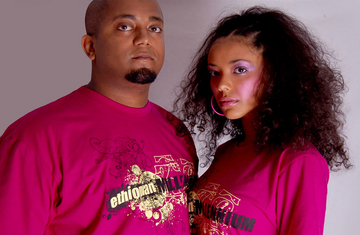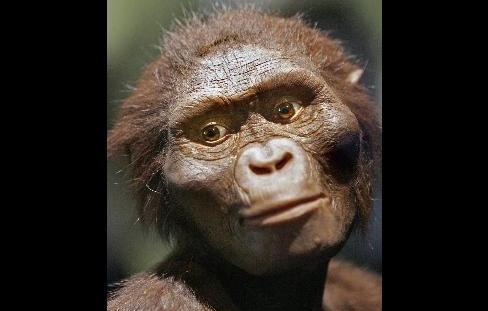
Models pose for the Ethiopian Millennium Tee by Bernos. Read about Bernos’ Ethiopian Millennium PhotoShoot.
By Ayele Bekerie, PhD
“Ethiopia has existed for 3,000 years. In fact, it existed ever since the first man [person] appeared on earth.” (Emperor Haile Selassie responding to an interview question by Italian journalist Oriana Fallaci on Sunday, June 24, 1973).
A Japanese historian observes that those who control their time, control their destiny. As we approach our millennium, it is appropriate to take inventory of our time, our historical time. How old are we? What is the significance of the human fossil discoveries in the Afar region of southeast Ethiopia that are dated in millions of years? How can we integrate different reckoning of time by our people into an Ethiopian sense of temporality? Such questions, responses to them and the consensus we reach are useful in shaping the present and planning for the future. The purpose of this article is to rethink the Ethiopian sense of time and to suggest an alternative organization of it.
Since the middle of the twentieth century, our understanding of historical time has changed, thanks to the scholarly works of archaeologists, paleontologists, historians, biologists, and geologists. Our sense of time has been stretched to seven digits into millions. Even though we are preparing for a grand celebration of the Ethiopian millennium, we all agree, thanks to the works of paleo-anthropologists, our time begins with the beginning of humanity. The evidence obtained from the Afar region, among other useful sites in the vast Rift Valley, suggests that southeast Ethiopia may have been the cradle of human beings. In other words, our sense of time has expanded beyond the 2000 years we want to acknowledge with grand celebration. Simply put, we are a million years old people. Such a time scale should help us to place our present language based differences in a proper perspective. We are time-endowed people with a claim to uninterrupted long human development.
Reckoning of time in the past, primarily concentrates on the events and traditions of northern Ethiopia. Of course, we salute the contribution of the Ethiopian Orthodox Church in the establishment and keeping of the time period that we know as Amate Mehret (Year of Mercy). We are grateful to them mapping out a time scale that embraces our conception and understanding of werat (months), ametat (years), and zemenat. We are also appreciative of the Church for the maintenance of Zemene Fitrit (Era of creation). Just as we recognize the diversity of our people, it is equally important to recognize the diverse reckoning of time by Ethiopians. Thanks to the Ethiopian Muslim chroniclers, time and events in the lowlands, coastal regions and in the southeastern part of the country have been recorded based on Islamic calendar. The Oromos have Gada system of time and community organizations based on age-grade. There may be numerous other ways of time reckoning in our country and we should study them and find ways of incorporating into our Ethiopian collective sense of time.
As I pointed out earlier, it is increasingly becoming clear that our sense of time has been greatly influenced by the discovery of early human fossils in the southeast part of the country. Dinqnesh (She has multiple names, including Lucy) has permanently registered in our psyche a sense of ancestral and resultant diversity. We do not argue about the ethnic origin of our eponymous ancestors. Time has placed them at the center of our origin and it will not be honest if we fail to include the ancestors in our calculation of self and community regardless of our immediate identity. Besides, Dinqnesh (Lucy) is the mother of all mothers and all the 6 billion people on earth can claim her. She is the universal ancestor and it is exciting to note that our beginning, given its universal dimension, as I stated earlier, is postmodern, postpositive, if I may use the discourse of our age. The tribal and ethnic entity that we currently debate about is subdued by time. Time ties us together.

A full-sized model of Dinqnesh (Lucy), the 3.2 million-year-old member of the Australopithecus afarensis, is displayed at the Houston Museum of Natural Science in Houston, Texas, on Aug. 29, 2007. Photographer: Craig Hartley/Bloomberg News
To organize our time, we may want to establish four general divisions: millions, thousands, millenniums, and centuries. Millions refer to the time period for the emergence of our ancestors. The foundation of our diversity is established during this period. Our ancestors moved in and out of our motherland in search of suitable locations for habitation. Significant human evolution has also taken place during this period.
Thousands coincide with the emergence of modern human beings. Researchers such as Sileshi Semaw have found reliable evidence to affirm our modernity. During this time, there was a movement out of Africa to populate the rest of the world. The process continued until thirty or forty thousand years ago.
Millenniums are regarded as a revolutionary period because the ancestors of this period succeeded in domesticating plants and animals. They were even credited for establishing one of the original sources of plant and animal species. Thanks to their diligent work, we now have four main occupations associated with our ecology: grain producers, meat and milk producers, inset producers and fishers. Oral traditions have also identified, together with some recorded history, the period as time of empire and international trade. Here I am particularly referring to Queen Makeda and her journey to Jerusalem.
Centuries are a time period measured in centuries. This is the period of great written and oral records. It is a period of events, including reorganization, tumultuous interaction, royal rule and egalitarian social formation. As we transition to the Ethiopian millennium, we should strive to cultivate participatory democracy.
Let me make another observation regarding the Ethiopian chronology or detailed recorded time lines of our past. The study of ancient Egypt begins with ancient Egyptian chronology, which was developed by Manetho in the third century B.C., at least 2, 800 years after the establishment of the first dynasty. Manetho identified thirty Egyptian dynasties in the historical period of 3100 years. The dynasties were divided into three major kingdoms: old, middle and new Egyptian kingdoms. Regardless of the location of the capitals of the dynasties, they always remained Egyptian dynasties and not Memphite, Thebite, or Napatan dynasties. The benefit of the Egyptian chronology is that it ties all the dynasties as one historical epoch. This is not what we find with Ethiopian chronology.
The name of the chronology shifts with the changing capitals of the Ethiopian rulers. We have chronological time calculated on the basis of events that took place in the northern part of Ethiopia, such as Damot, Aksum, Zagwe, Gondar, and Shoa. Even then the names of the different periods in the chronology give an impression as if there is no continuity or relations.
Furthermore, the chronology does not present the whole historical time encompassing all Ethiopian historical events. I am proposing to reckon and organize Ethiopian time in such a way that we will have Ethiopian Time I at Afar (4.4 million years to 18, 000 years), Ethiopian Time II at Teffland, Ensetland, and Pastoral land (18, 000 years to 1, 000 years), Ethiopian Time III at Damot (1,000 years to 300 BCE), Ethiopian Time IV at Aksum (300 BCE to 1,000 CE), Ethiopian Time V at Zagwe (1200 to 1400 CE), Ethiopian Time VI of Oromo Kingdoms, Afar Sultanates and others (1400 to 1600 CE), Ethiopian Time VII at Gondar (1600 to 1800), Ethiopian Time at Kaffa, Konso, Anuak, Shoa and other states as well as the movement towards a federal republic (1800 to Present). This new proposal also helps us to incorporate all Ethiopian autonomous states, such as Kaffa kingdom, Jotte kingdom, Afar Sultanate, particularly in the southern part of Ethiopia.
As we prepare to celebrate the Ethiopian millennium, it is perhaps appropriate to place our historical time in order. It is also important to organize our historical time so as to promote “the cardinal rule of unity in diversity.”
Our sense of time should assist us to develop a sense of unity. It is important to remember that we are celebrating our second millennium where we can demonstrate continuous and free living. It is an important mark of time that certainly deserves a big celebration. However, we should always be aware of the fact that our age is measured in millions of years. That should also help us to place all our immediate differences in some kind of proper perspective.
———————
About the Author:

Ayele Bekerie was born in Ethiopia, and earned his Ph.D. in African American Studies at Temple University in 1994. He has written and published in scholarly journals, such as , ANKH: Journal of Egyptology and African Civilizations, Journal of Black Studies, The International Journal of Africana Studies, and Imhotep. He is an Assistant Professor at the Africana Studies and Research Center of Cornell University. He is also a regular contributor to Tadias Magazine.
******************************
How to Advertise
To learn about advertising, Click Here.
******************************>

























